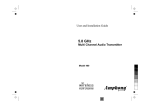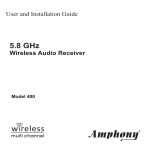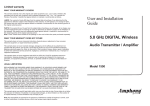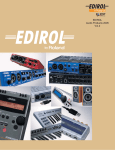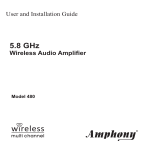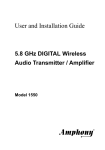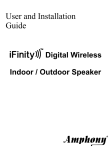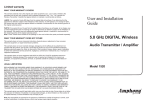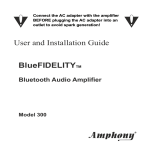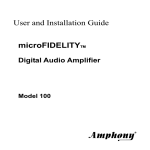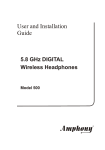Download Amphony 400 Installation guide
Transcript
User and Installation Guide 5.8 GHz Multi Channel Audio Transmitter Model 400 R Contents Unpacking ................................................................................. 3 Connecting the transmitter ........................................................ 3 Placing the transmitter ............................................................... 6 Operating the transmitter ........................................................... 6 Troubleshooting ......................................................................... 7 Technical specifications ............................................................. 9 Safety information ................................................................... 10 Limited Warranty ..................................................................... 12 User and Installation Guide Unpacking: Check that this package contains: One 5.8 GHz Digital Audio transmitter - Model 400, one 9 V AC adapter (wallwart), four short speaker cables, two RCA audio cables. Step 1 Connecting the transmitter The transmitter has two stereo audio inputs, one zone-A and one zone-B input. 4 audio channels can be transmitted simultaneously. Both zone-A and zone-B audio inputs can connect either to an unbalanced line-level audio output or a balanced amplified speaker output. For best audio quality, we recommend using the unbalanced line-level audio input. The transmitter can transmit to Model 400 wireless audio receivers and Model 480 wireless amplifiers. Each audio channel is encoded with a channel ID and can be selected by each wireless receiver. Note: Regardless of whether any specific audio channel is transmitted to a wireless receiver or wireless amplifier, both the transmitter line-level and amplified speaker audio inputs can be used to feed audio into the transmitter. Connect the transmitter to an unbalanced audio input by using the supplied phoneRCA audio cable. Connect the phone jack with the line level input of the transmitter and the RCA jack with the RCA output of your audio source. Alternatively, connect the transmitter to an amplified speaker output by using the supplied speaker cables. Be sure to observe the correct polarity of the speaker cable. If one of the speaker cables is switched (reversed), one speaker will receive an opposite polarity signal which will degrade sound performance. It is possible to connect zone-A audio inputs to line-level audio outputs and zone-B audio inputs to amplified speaker outputs and vice versa. However, only the unbalanced line level input or speaker inputs of each zone can be used, i.e. you cannot mix audio inputs within a zone. Connect the supplied small AC adapter’s barrel-shaped plug into the DC 9V jack, and then plug the transformer into a standard AC outlet. We recommend the use of a surge protector to protect the transmitter from power surges. ATTENTION! Do not connect both the line level audio input and amplified speaker audio input of the same zone. This may damage your audio source. Page 3 R R User and Installation Guide Transmitter audio inputs Line level Amplified input A speaker inputs L DC 9V A R L Line level input B B R LINE IN A LINE IN B Zone A Inputs Zone B Inputs Copyright (C) 2010 Amphony. All rights reserved. The information contained herein is subject to change without notice. Revisions may be issued to advise of such changes and/or additions. All product names, trade names, or corporate names mentioned in this document are acknowledged to be the proprietary property of the registered owners. FCC ID PMJT400 This device complies with part 15 of the FCC Rules. Operation is subjected to the following two conditions: 1) This device may not cause harmful interference and 2) this device must accept any interference received, including interference that may cause undesired operation. Caution: Any changes or modifications not expressly approved by the party responsible for compliance could void the user's authority to operate the equipment. R User and Installation Guide L DC 9V A R L B R LINE IN A LINE IN B L R SPEAKER OUT L R LINE OUT Audio Source AC adapter DC 9 V Power outlet Example: Using the amplified Zone-A speaker inputs and Zone-B line level audio input Page 5 R User and Installation Guide Step 2 Placing the transmitter Ideally, the transmitter should be placed at an elevation such that there are no obstacles between the transmitter and wireless receivers or amplifiers (line of sight) in an area where there will be the least amount of traffic. We suggest that you place the transmitter on top of your audio source. Step 3 Operating the transmitter The green transmit light of the transmitter will be on when audio is transmitted. If you are using the speaker outputs, adjust the audio level of your audio source to the maximum level where no clipping / distortion occurs at the wireless receivers. If the audio level supplied to the transmitter is too high, then distortion will occur. If the audio level is too low, the dynamic range of the transmission will not be used and the audio level at the receiver may be too low. If you are using a line-level audio output and the audio level is too low, try instead using an audio output with audio volume regulator such as a headphone output. The transmitter can connect to a headphone output by using a phone jack-to-phone jack cable. If audio reception is poor, try raising the transmitter and changing the transmitter location until reception is acceptable. If no audio signal is present, the transmitter will go into standby mode after approximately two minutes. The transmitter will wake up as soon as an audio signal is present. Page 6 R User and Installation Guide Troubleshooting Problem Possible Cause Solution The trans mit light does not go on after DC pow er is applied to the transmitter The trans mit light goes out after a few seconds and does not light again Faulty AC adapter or faulty power outlet Check the power outl et and the AC adapter; if poss ible, check for correct voltage of the AC adapter. No audio present at audio input Check the audio connection to the transmitter and ensure that there is audio pr es ent. Di sconnect and then reconnect DC power. Check the receiver power supply . No audio at recei ver Transmitter hung up Faulty AC adapter or faulty power outlet Strong interferenc e Audio is dis torted Audio v olume too high Amplifier volume control set too high Strong interferenc e Receiver audio level is too low Audio v olume too low Amplifier volume control set too low Audio drops out inter mittently or crackles Page 7 Strong interferenc e Unstable power supply / power surges See under “Strong Interference“ on next page. Adjust the transmitter volume control until clipping stops. Lower the s ource audio volum e until cli pping stops . See under “Strong Interference“ on next page. Raise the source audio volume to achieve the desired audio level. Connect transmi tter to an adjustable audio output Adjust the amplifier vol ume control to ac hiev e des ired audio level. See under “Strong Interference“ on next page. Ensure that the power outlet deli vers a stable voltage. Very strong surges or voltage fluc tuations may cause audio dr opouts. Tr y using a s urge pr otector. R User and Installation Guide Problem Possible Cause Solution Transmitter range is extremely s hort Strong interferenc e In some cas es , there may be strong interference preventing pr oper rec eption of the audio signal which can be caused by 5.8 GHz cordless telephones or 5.8 GHz wireless networks . Either eliminate the interferenc e, loc ate the base unit of the cor dless phone in another room, set the wi reless network to use the 5.1 GHz frequency band rather than 5.8 GHz , reloc ate the transmitter, reloc ate or reorient the amplifier to im prove reception. Audio will dr op out if there are too many obstacles between the trans mitter and the rec eiver, try reloc ating the tr ans mitter or recei ver to i mpr ove rec eption. Too many obstacles For up-to-date troubleshooting advice, visit www.amphony.com Page 8 User and Installation Guide Technical Specifications: Audio transmission: Digital Transmitter frequency: 5.8 GHz Number of wireless audio channels: 4 Operating range: - max. 150 ft line of sight - max. 30 ft through walls and obstacles Compatible wireless receivers: - Model 400 wireless audio receiver - Model 480 wireless audio amplifier Audio inputs: - 4 x speaker-level input - 2 x stereo line-level input Signal-to-noise ratio: typ. 96 dB (A-weighted) Frequency response: 2 Hz - 20 kHz Audio latency: < 1 ms Total harmonic distortion: -90 dB (0.003%) Transmitted data rate: 6 Mbps Error correction: 1/2 rate FEC Channel separation: 95 dB Audio input level: max. 3 Vrms Automatic power-down feature Page 9 R R User and Installation Guide IMPORTANT SAFETY INFORMATION ATTENTION! READ THESE SAFETY INSTRUCTIONS CAREFULLY AND HEED ALL WARNINGS IN THIS MANUAL. POWER SOURCE To product malfunction, and to protect against electric shock, fire or personal injury, please observe the following: • This product has been designed to work with 120-volt AC current using the supplied AC adapters. Connection to a line voltage other than that or use of non-compatible AC adapters may create a safety and fire hazard and may damage the product. • Do not run power cords under rugs or carpets or place heavy objects on them. • Damaged or deformed power cords are hazardous and should be replaced immediately by a qualified service technician. LOCATION • Do not use this product outdoors or in cars. • Do not place this product in direct sunlight, or near heat sources. • Keep this product away from strong magnetic objects. VOLUME CONTROL • Do not turn up the amplifier volume while listening to a portion with very low level input or no audio signal to avoid damage to your speakers during a peak level audio portion. • Turn the amplifier volume control to minimum prior to connecting or disconnecting the transmitter or amplifier and prior to switching audio sources as this may cause loud clicks which can damage your speakers. CARE • Do not place any object containing water or other liquids on this product. • Do not remove the cabinet. Touching parts inside the cabinet could result in electric shock and damage to the product. NON-USE PERIODS • When the product is not being used for a long period of time, unplug the product. Page 10 User and Installation Guide CLEANING • Unplug the product before cleaning. • When the system gets dirty, wipe it with a clean, soft cloth. If necessary, wipe it with a soft cloth, slightly dampened with soapy water. Wipe dry immediately with a dry cloth. • Never use benzene, aerosol cleaners, thinner, alcohol or any volatile cleaning agent. • Do not use abrasive cleaners, as they may damage the finish. SERVICE • Do not open the cabinet of any components. Opening the cabinets may present a shock hazard, and any modification to this product will void your warranty. • Do not attempt to service the unit yourself. • Please refer any service to an authorized Amphony service center. Page 11 R R User and Installation Guide Limited warranty WHAT YOUR WARRANTY COVERS This warranty extends only to the original user of the equipment (“you”, ”your”) and is limited to the purchase price of each part. Amphony and its affiliated companies (”we”, ”our”, ”us”) warrant this Multi Channel Audio Transmitter against defects in materials or workmanship as follows. LABOR: For a period of ninety (90) days from the original date of purchase, if we determine that the equipment is defective subject to the limitations of this warranty, we will replace it at no charge for labor. We warrant any such work done against defects in materials or workmanship for the remaining portion of the original warranty period. PARTS: For a period of one (1) year from the original date of purchase, we will supply, at no charge, new or rebuilt replacement parts in exchange for parts we determine are defective subject to the limitations of this warranty. We warrant any such replacement parts against defects in materials or workmanship for the remaining portion of the original warranty period. Note: ”Parts” means items included in this package. It does not include other parts purchased separately. WHAT YOUR WARRANTY DOES NOT COVER This warranty does not cover consumer instruction, physical setup or adjustment of any consumer electronic equipment, or signal transmission problems. This warranty does not cover cosmetic damage, damage due to the affixing of any attachment not provided with the product, loss of parts, connecting the product to any but the specified receptacles, lightning, electrical surges, fire, flood, or other acts of God, accident, misuse, abuse, repair or alteration by other than authorized service personnel, negligence, commercial or institutional use, or improper or neglected maintenance. This warranty does not cover equipment sold AS IS or WITH ALL FAULTS, equipment removal or reinstallation, shipping damage if the equipment was not packed and shipped in the manner we prescribe, nor equipment purchased, serviced, or operated outside the contiguous United States of America. Page 12 User and Installation Guide LEGAL LIMITATIONS REPLACEMENT AS PROVIDED UNDER THIS WARRANTY IS YOUR EXCLUSIVE REMEDY. WE SHALL NOT BE HELD LIABLE FOR ANY INCIDENTAL OR CONSEQUENTIAL DAMAGES FOR BREACH OF ANY EXPRESSED OR IMPLIED WARRANTY ON THIS EQUIPMENT, NOR FOR ANY INCIDENTAL OR CONSEQUENTIAL DAMAGES RESULTING FROM THE USE OF, OR INABILITY TO USE, THIS EQUIPMENT. UNDER NO CIRCUMSTANCES SHALL OUR LIABILITY, IF ANY, EXCEED THE PURCHASE PRICE PAID FOR THIS EQUIPMENT, EXCEPT TO THE EXTENT PROHIBITED BY APPLICABLE LAW. EXCEPT AS PROVIDED HEREIN, WE MAKE NO WARRANTIES, EXPRESS OR IMPLIED, INCLUDING WARRANTIES OF MERCHANTABILITY AND FITNESS FOR A PARTICULAR PURPOSE. WE RESERVE THE RIGHT TO REFUSE TO HONOR THIS WARRANTY IF WE DETERMINE ANY OF THE ABOVE EXCEPTIONS TO HAVE CAUSED THIS EQUIPMENT NOT TO HAVE PERFORMED PROPERLY. THIS WARRANTY SHALL BE VOID IF ANY FACTORY-APPLIED IDENTIFICATION MARK, INCLUDING BUT NOT LIMITED TO SERIAL NUMBERS AND WARRANTY LABELS, HAS BEEN ALTERED OR REMOVED. THIS WARRANTY SHALL ALSO BE VOID IF THE TRANSMITTER OR AMPLIFIER HAVE BEEN OPENED BY AN UNAUTHORIZED PERSON. This warranty gives you specific legal rights which may vary from state to state. Some states do not allow the exclusion or limitation of incidental or consequential damages, or allow limitations on the duration of an implied warranty, so those limitations may not apply to you. Note: No responsibility is assumed for the presence of interference outside of Amphony’s control, such as other transmitters or cordless phones, which may hamper proper signal reception. R













